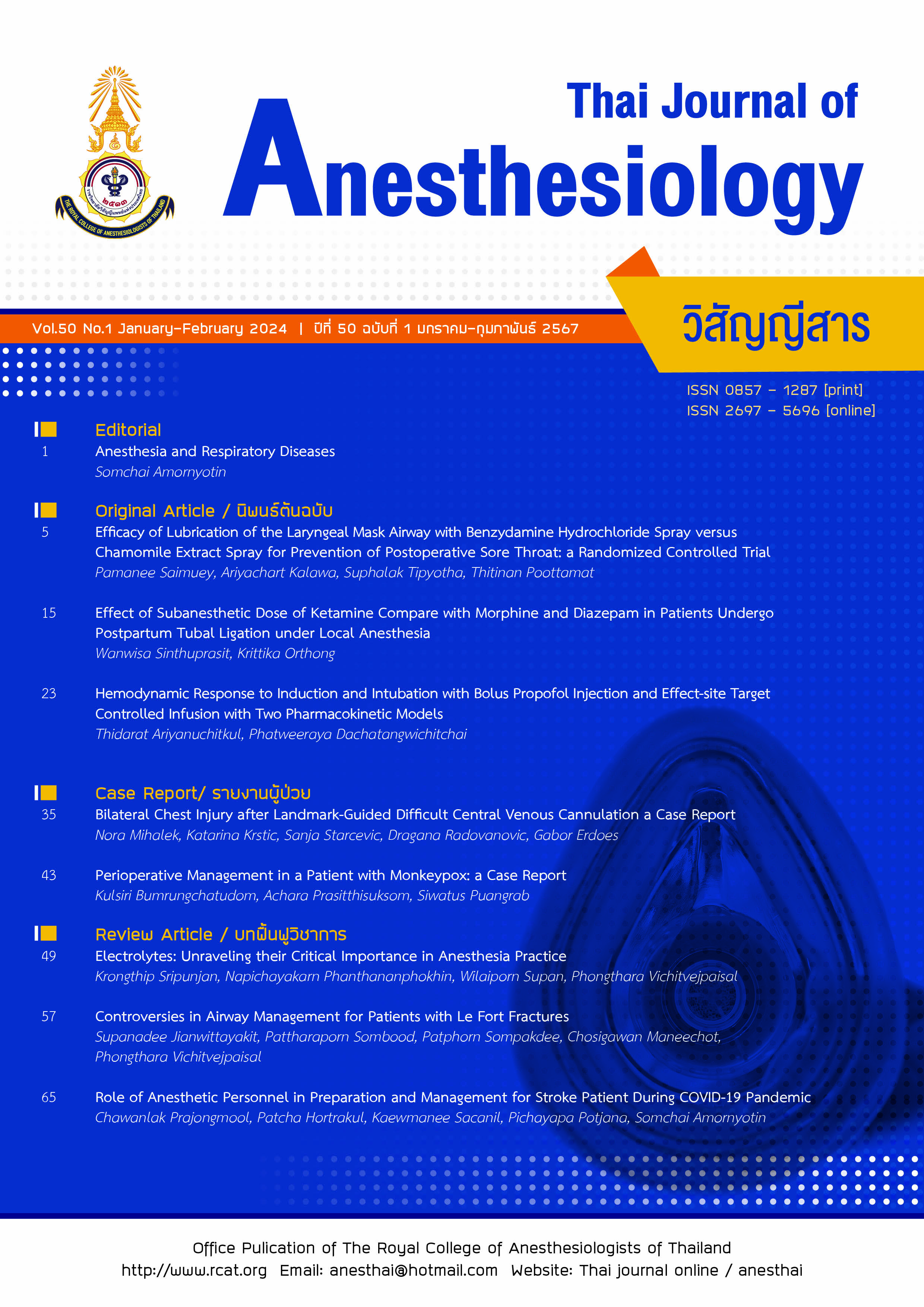Hemodynamic Response to Induction and Intubation with Bolus Propofol Injection and Effect-site Target Controlled Infusion with Two Pharmacokinetic Models
Main Article Content
Abstract
Background: Propofol, a sedative-hypnotic agent, is associated with hemodynamic stability. Different anesthetic induction techniques by propofol will produce different hemodynamic responses. The objective of the study is to compare the hemodynamic changes during anesthesia induction between 3 different induction methods. Methods: One hundred and sixty two patients who underwent elective surgery under general anesthesia were randomly assigned to three groups. The patients received propofol by Bolus injection, Schnider model and Marsh model. Blood pressure and heart rate were recorded before induction, after induction and every minute during the first 5 minutes after intubation. Induction time and dose of propofol were recorded. Results: Time to eyelash reflex loss and dose of propofol were significantly higher in Marsh model than Bolus injection and Schnider model group. Through the first 5 minutes after tracheal intubation, the blood pressure of Marsh model group was significantly lower than Bolus injection and Schnider model group. Neither heart rate nor oxygen saturation were significantly different between the three groups. Marsh model produce less hemodynamic changes than Bolus injection and Schnider model. Conclusion: Propofol-anesthesia administered via Marsh model TCI produced better hemodynamic stability than Bolus injection and Schnider model.
Article Details

This work is licensed under a Creative Commons Attribution-NonCommercial-NoDerivatives 4.0 International License.
References
Muzi M, Berens RA, Kampine JP, Ebert TJ. Venodilation contributes to propofol-mediated hypotension in humans. Anesth Analg. 1992;74:877-83.
Bienert A, Wiczling P, Grzeskowiak E, Cywinski JBJ, Kusza K. Potential pitfalls of propofol target controlled infusion delivery related to its pharmacokinetics and pharmacodynamics. Pharmacol Rep. 2012;64:782-95.
Sahinovic MM, Struys MMRF, Absalom AR. Clinical pharmacokinetics and pharmacodynamics of propofol. Clin Pharmacokinet. 2018;57:1539-58.
Absalom AR, Glen JIB, Zwart GJC, Schnider TW, Struys MMRF. Target-controlled infusion: a mature technology. Anesth Analg. 2016;122:70-8.
Wakeling HG, Zimmerman JB, Howell S, Glass PSA. Targeting effect compartment or central compartment concentration for propofol. Anesthesiology. 1999;90:92-7.
Struys MM, Smet TD, Depoorter B, et al. Comparison of plasma compartment versus two methods for effect compartment-controlled target-control infusion for propofol. Anesthesiology. 2000;92:399-406.
Nunes CS, Ferreira DA, Antunes L, Lobo F, Santos IA, Amorim P. Individual effect-site concentrations of propofol at return of consciousness are related to the concentration at loss of consciousness and age in neurosurgical patients. J Clin Anesth. 2009;21:3-8.
Ghislaine CE, Maria FE, Maria TD, Diago AB, Luis IC, Hernan RM. The effective effect-site propofol concentration for induction and intubation with two pharmacokinetics models in morbidly obese patients using total body weight. Anesth Analg. 2012;115:823-9.
Anthony RA, Vaithy M, Tom DS, Michel MRFS. Pharmacokinetics models for propofol-defining and illuminating the devil in the detail. Br J Anaesth. 2009;103:26-37.
Yang XY, Zhou ZB, Yang L, Zhou X, Niu LJ, Feng X. Hemodynamic responses during induction: comparison of Marsh and Schnider pharmacokinetic models. Int J Clin Pharmacol Ther. 2015;53:32-40.
Marsh B, White M, Mortan N, Kenny GN. Pharmacokinetic model driven infusion of propofol in children. Br J Anesth. 1991;67:41-8.
Struy MMRF, De Smet T, Depoorter B, Verichelen LFM, Mortier EP, Dumortier FJE, et al. Comparison of plasma compartment versus two methods for effect compartment-controlled target controlled infusion for propofol. Anesthesiology. 2000;92:399-406.
Joao FV, Andre PL, Adelino FL, Paulo P, Fernanda B. Prospective randomised comparison of Marsh and Schnider pharmacokinetic models for propofol during induction of anaesthesia in elective cardiac surgery. Eur J Anaesthesiol. 2012;29:477-83.
Mathew PJ, Sailam S, Sivasailam R, Thingnum S, Puri GD. Performance of target-controlled infusion of propofol using two different pharmacokinetics models in open heart surgery-a randomised controlled study. Perfusion. 2015;31:45-53.
Zheng D, Upton RN, Martinez AM, Grant C, Ludbrook GL. The influence of propofol on it cardiovascular effects and peak blood concentrations in sheep. Anesth Analg. 1998;86:1109-15.
Schnider TW, Minto TF, Shafer SL, et al. The influence of age on propofol pharmacodynamics. Anesthesiology. 1999;90:1502-16.
Ouattara A, Boccara G, Lemaire S, et al. Target-controlled infusion of propofol and remifentanil in cardiac anesthesia: influence of age on predicted effect-site concentrations. Br J Anaesth. 2003;90:617-22.
Barakat AR, Sutcliffe N, Schwab M. Effect site concentration during propofol TCI sedation: a comparison of sedation score with two pharmacokinetic models. Anaesthesia. 2007;62:661-6.
Peacock JE, Lewis RP, Reilly CS, Nimmo WS. Effect of different rates of infusion of propofol for induction of anaesthesia in elderly patients. Br J Anaesth. 1990;65:346-52.
Fuentes R, Cortinez I, Ibacache M, Concha M, Munoz H. Propofol concentration to induce general anesthesia in children aged 3-11 years with the Kataria effect-site model. Paediatr Anaesth. 2015;25:554-9.


